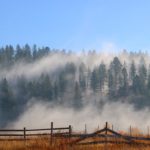Social Science
Posted: November 9, 2017Source: The Forest Blog by Russ Vaagen

Uneven Age Management
I always called it uneven-age management. This meant leaving trees in multiple age classes after harvest. Sure, it didn’t result in the same type of financial windfall that cutting every last tree. What it did do was create happy to at least neutral neighbors. Over the long haul these landowners, including my family, didn’t get the big paydays that clearing it all would garner, but it was still more than enough. This may not work in all areas. I understand that. It does, however, work very well in our fire-prone forests of the intermountain west.
I always thought looking at a forest as a crop was a misguided approach. At least where I grew up. I always looked at it as constant management. In my mind, it was pretty simple. You have a minimum stocking level and a maximum. Anytime the forest approached, reached, or exceeded that level it was time to manage it. Depending on the location and the sensitivity of the site you would manage it to some level, but not exceed the minimum stocking level. Fortunately, the forests recover with time, but if managed well there really wasn’t a recovery period. Just a shift from high levels to acceptable lower levels.
More Social Science needed
It was about ten or fifteen years ago I starting thinking about it as a social science rather than a physical science. Managing forests are as much about how people feel about the forest as it is about growing trees. Today I am convinced of this idea. I know there are those out there that will argue with me and say we need to let the “professionals” do the work. To that, I would respectfully disagree and argue that we need a balancing act of professionals from many disciplines. Some of those have to do with managing people and relationships rather than just trees.
My friend Bob Williams from New Jersey that is working on many similar issues. He recently shared a talk that Jerry Franklin recently gave in New Jersey and I have to say it was powerful. We need to get to a place where the public is generally comfortable with where we manage as well as how we manage. If we can create a clearly described system of the upper and lower limits for each forest and people are confident that the work is balancing the needs of the people with ecological impacts we will be able to scale.
Scale the Solution
Scale is a serious issue that needs to be addressed. Our public lands are so out of balance that we need to do far more management than we are currently capable. We are beyond the upper limits of stocking in most of our public forestland. It desperately needs brought back within the natural limits and quickly. This is one of the major factors in our out-of-control wildfire situation. It’s not just climate change, it’s too many trees and too much brush. Those things are all fuel for fires.
If we can bring the forests closer to their lower acceptable limits, these fires will behave much differently. The forests will survive and thrive with the fire. Not only will this benefit our forests, it will drastically impact our state and federal budgets. Imagine if we could reduce our firefighting crews by half, create safer, more manageable conditions during fires. If we could do that, why wouldn’t we? I think people fail to believe the solution is so simple. We must reduce the fuels in ways that match up with the values of the public. Balancing the needs of everyone concerned to make our forests healthier, safer, and more beneficial to our rural communities.

